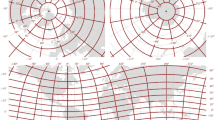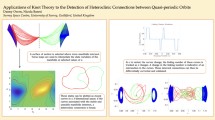Abstract
The six-dimensional phase space of the circular restricted three-body problem offers opportunities to exploit dynamics commonly found in the Solar System for unique spacecraft trajectories. Poincaré first introduced the idea of reducing the phase space by observing a surface of section, or a Poincaré map. In this paper, we show an alternate map parameterization that classifies trajectories according to their qualitative end state and reflects their status onto an initial condition grid. While this method does not allow a visualization of the entire phase space at once, it does allow insight into reduced regimes of the phase space.





















Similar content being viewed by others
References
Anderson, R.L., Lo, M.W.: Virtual exploration by computing global families of trajectories with supercomputers. In: Proceedings of the 15th AAS/AIAA space flight mechanics meeting, number AAS 05-220 in 1, Copper Mountain, Colorado (2005)
Anderson, R.L., Parker, J.S.: Survey of ballistic transfers to the lunar surface. J. Guid. Control Dyn. 35(4), 1256–1267 (2012)
Anderson, R.L., Parker, J.S.: Comparison of low-energy lunar transfer trajectories to invariant manifolds. Celest. Mech. Dyn. Astron. 115(3), 311–331 (2013)
Breakwell, J.V., Brown, J.V.: The ’halo’ family of 3-dimensional periodic orbits in the Earth–Moon restricted 3-body problem. Celest. Mech. 20, 389–404 (1979)
Davis, D.C., Howell, K.C.: Trajectory evolution in the multi-body problem with applications in the Saturnian system. Acta Astronaut. 69(11–12), 1038–1049 (2011)
Davis, D.C., Howell, K.C.: Characterization of trajectories near the smaller primary in restricted problem for applications. J. Guid. Control Dyn. 35(1), 116–128 (2012)
Fehlberg, E.: Classical fifth-, sixth-, seventh-, and eighth-order runge-kutta formulas with stepsize control. NASA Technical Report TR R-287, National Aeronautics and Space Administration, George C. Marshall Space Flight Center, Marshall, Alabama (1968)
Haapala, A.F., Howell, K.C.: Trajectory design strategies applied to temporary comet capture including Poincaré maps and invariant manifolds. Celest. Mech. Dyn. Astron. 116, 299–323 (2013)
Haapala, A.F., Howell, K.C.: Representations of higher-dimensional Poincaré maps with applications to spacecraft trajectory design. Acta Astronaut. 96, 23–41 (2014)
Howell, K.C., Breakwell, J.V.: Almost rectilinear halo orbits. Celest. Mech. 32(1), 29–52 (1984)
Howell, K.C., Pernicka, H.J.: Numerical determination of lissajous trajectories in the restricted three-body problem. Celest. Mech. 41, 107–124 (1988)
Jorba, À., Masdemont, J.: Dynamics in the center manifold of the collinear points of the restricted three body problem. Phys. D: Nonlinear Phenom. 132(1–2), 189–213 (1999)
Kolemen, E., Kasdin, N.J., Gurfil, P.: Multiple Poincaré sections method for finding the quasiperiodic orbits of the restricted three body problem. Celest. Mech. Dyn. Astron. 112, 47–74 (2012)
Miele, A.: Theorem of image trajectories in the Earth–Moon space. Acta Astronaut. 6(5), 225–232 (1960)
Miele, A.: Revisit of the theorem of image trajectories in the Earth–Moon space. J. Optim. Theory Appl. 147(3), 483–490 (2010)
Mondelo, J.-M., Ollé, M., de Sousa-Silva, P.A., Terra, M.O.: Families of heteroclinic connections between quasi-periodic libration point trajectories. In: 65th international astronautical congress 2014, Toronto, Canada (2014)
Parker, J.S.: Low-Energy Ballistic Lunar Transfers. Ph.D. thesis, University of Colorado (2007)
Parker, J.S., Anderson, R.L.: Low-Energy Lunar Trajectory Design. Deep-Space Communications and Navigation Series. Jet Propulsion Laboratory, California Institute of Technology, Wiley (2014)
Paskowitz, M.E., Scheeres, D.J.: Robust capture and transfer trajectories for planetary satellite orbiters. J. Guid. Control Dyn. 29(2), 342–353 (2006)
Richardson, D.L.: Analytic construction of perioidic orbits about the collinear points. Celest. Mech. 22, 241–253 (1980)
Szebehely, V.G.: Theory of Orbits: The Restricted Problem of Three Bodies. Academic Press, New York (1967)
Utku, A.: Low Cost Capture Using Multi-Body Dynamics. Ph.D. thesis, University of Surrey (2013)
Villac, B.F., Scheeres, D.J.: Escaping trajectories in the Hill three-body problem and applications. J. Guid. Control Dyn. 26(2), 224–232 (2003)
Author information
Authors and Affiliations
Corresponding author
Rights and permissions
About this article
Cite this article
Utku, A., Hagen, L. & Palmer, P. Initial condition maps of subsets of the circular restricted three-body problem phase space. Celest Mech Dyn Astr 123, 387–410 (2015). https://doi.org/10.1007/s10569-015-9641-4
Received:
Revised:
Accepted:
Published:
Issue Date:
DOI: https://doi.org/10.1007/s10569-015-9641-4




